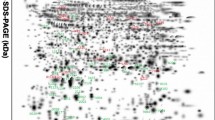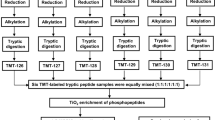Abstract
Objective
Molecular pathogenesis of parathyroid tumors is incompletely understood. Identification of novel molecules and understanding their role in parathyroid tumorigenesis by proteomics approach would be informative with potential clinical implications.
Method
Adenomatous (n = 5) and normal (n = 2) parathyroid tissue lysates were analyzed for protein profile by LC–MS/MS method and the proteins were classified using bioinformatics tools such as PANTHER and toppfun functional enrichment tool. Identified proteins were further validated by western blotting and qRT-PCR (n = 20).
Result
Comparative proteomics analysis revealed that a total of 206 proteins (74 upregulated and 132 downregulated) were differentially expressed (≥ twofold change) in adenomas. Bioinformatics analysis revealed that 48 proteins were associated with plasma membrane, 49 with macromolecular complex, 39 were cytoplasm, 38 were organelle related, 21 were cell junction and 10 were extracellular proteins. These proteins belonged to a diverse protein family such as enzymes, transcription factors, cell signalling, cell adhesion, cytoskeleton proteins, receptors, and calcium-binding proteins. The major biological processes predicted for the proteins were a cellular, metabolic and developmental process, cellular localization, and biological regulation. The differentially expressed proteins were found to be associated with MAPK, phospholipase C (PLC) and phosphatidylinositol (PI) signalling pathways, and with chromatin organization. Western blot and qRT-PCR analysis of three proteins (DNAJC2, ACO2, and PRDX2) validated the LC–MS/MS findings.
Conclusion
This exploratory study demonstrates the feasibility of proteomics approach in finding the dysregulated proteins in benign parathyroid adenomas, and our preliminary results suggest that MAPK, PLC and PI signalling pathways and chromatin organization are involved in parathyroid tumorigenesis.





Similar content being viewed by others
References
Fraser WD (2009) Hyperparathyroidism. Lancet 374:145–158
Bilezikian JP, Brandi ML, Eastell R, Silverberg SJ, Udelsman R, Marcocci C, Potts JT Jr (2014) Guidelines for the management of asymptomatic primary hyperparathyroidism: summary statement from the Fourth International workshop. J Clin Endocrinol Metab 99:3561–3569
Bhadada SK, Arya AK, Mukhopadhyay S, Khadgawat R, Sukumar S, Lodha S, Singh DN, Sathya A, Singh P, Bhansali A (2018) Primary hyperparathyroidism: insights from the Indian PHPT registry. J Bone Miner Metab 36:238–245
Arnold A, Shattuck TM, Mallya SM, Krebs LJ, Costa J, Gallagher J, Wild Y, Saucier K (2002) Molecular pathogenesis of primary hyperparathyroidism. J Bone Miner Res 17(Suppl 2):N30–N36
Varshney S, Bhadada SK, Sachdeva N, Arya AK, Saikia UN, Behera A, Rao SD (2013) Methylation status of the CpG islands in vitamin D and calcium-sensing receptor gene promoters does not explain the reduced gene expressions in parathyroid adenomas. J Clin Endocrinol Metab 98:E1631–E1635
Varshney S, Bhadada SK, Saikia UN, Sachdeva N, Behera A, Arya AK, Sharma S, Bhansali A, Mithal A, Rao SD (2013) Simultaneous expression analysis of vitamin D receptor, calcium-sensing receptor, cyclin D1, and PTH in symptomatic primary hyperparathyroidism in Asian Indians. Eur J Endocrinol 169:109–116
Rao SD, Bhadada SK, Parfitt AM (2015) Parathyroid growth: normal and abnormal. In: Bilezikian JP (ed) The parathyroids, 3rd edn. Academic Press, San Diego, pp 255–278
Carling T (2001) Molecular pathology of parathyroid tumors. Trends Endocrinol Metab 12:53–58
de Hoog CL, Mann M (2004) Proteomics. Annu Rev Genomics Hum Genet 5:267–293
Kocher T, Superti-Furga G (2007) Mass spectrometry-based functional proteomics: from molecular machines to protein networks. Nat Methods 4:807–815
Ramaswamy S, Tamayo P, Rifkin R, Mukherjee S, Yeang CH, Angelo M, Ladd C, Reich M, Latulippe E, Mesirov JP, Poggio T, Gerald W, Loda M, Lander ES, Golub TR (2001) Multiclass cancer diagnosis using tumor gene expression signatures. Proc Natl Acad Sci USA 98:15149–15154
Giusti L, Cetani F, Ciregia F, Da Valle Y, Donadio E, Giannaccini G, Banti C, Pardi E, Saponaro F, Basolo F, Berti P, Miccoli P, Pinchera A, Marcocci C, Lucacchini A (2011) A proteomic approach to study parathyroid glands. Mol BioSyst 7:687–699
Donadio E, Giusti L, Cetani F, Da Valle Y, Ciregia F, Giannaccini G, Pardi E, Saponaro F, Torregrossa L, Basolo F, Marcocci C, Lucacchini A (2011) Evaluation of formalin-fixed paraffin-embedded tissues in the proteomic analysis of parathyroid glands. Proteome Sci 9:29
Varshney S, Bhadada SK, Arya AK, Sharma S, Behera A, Bhansali A, Rao SD (2014) Changes in parathyroid proteome in patients with primary hyperparathyroidism due to sporadic parathyroid adenomas. Clin Endocrinol (Oxf) 81:614–620
Mi H, Lazareva-Ulitsky B, Loo R, Kejariwal A, Vandergriff J, Rabkin S, Guo N, Muruganujan A, Doremieux O, Campbell MJ, Kitano H, Thomas PD (2005) The PANTHER database of protein families, subfamilies, functions and pathways. Nucleic Acids Res 33:D284–D288
Chen J, Bardes EE, Aronow BJ, Jegga AG (2009) ToppGene Suite for gene list enrichment analysis and candidate gene prioritization. Nucleic Acids Res 37:W305–W311
Szklarczyk D, Franceschini A, Wyder S, Forslund K, Heller D, Huerta-Cepas J, Simonovic M, Roth A, Santos A, Tsafou KP, Kuhn M, Bork P, Jensen LJ, von Mering C (2015) STRING v10: protein-protein interaction networks, integrated over the tree of life. Nucleic Acids Res 43:D447–D452
Arya AK, Bhadada SK, Singh P, Sachdeva N, Saikia UN, Dahiya D, Behera A, Bhansali A, Rao SD (2017) Promoter hypermethylation inactivates CDKN2A, CDKN2B and RASSF1A genes in sporadic parathyroid adenomas. Sci Rep 7:3123
Livak KJ, Schmittgen TD (2001) Analysis of relative gene expression data using real-time quantitative PCR and the 2(-Delta Delta C(T)) Method. Methods 25:402–408
Broad LM, Braun FJ, Lievremont JP, Bird GS, Kurosaki T, Putney JW Jr (2001) Role of the phospholipase C-inositol 1,4,5-trisphosphate pathway in calcium release-activated calcium current and capacitative calcium entry. J Biol Chem 276:15945–15952
Putney JW, Tomita T (2012) Phospholipase C signaling and calcium influx. Adv Biol Regul 52:152–164
Bittremieux M, Parys JB, Pinton P, Bultynck G (2016) ER functions of oncogenes and tumor suppressors: modulators of intracellular Ca(2+) signaling. Biochim Biophys Acta 1863:1364–1378
Balbas-Martinez C, Sagrera A, Carrillo-de-Santa-Pau E, Earl J, Marquez M, Vazquez M, Lapi E, Castro-Giner F, Beltran S, Bayes M, Carrato A, Cigudosa JC, Dominguez O, Gut M, Herranz J, Juanpere N, Kogevinas M, Langa X, Lopez-Knowles E, Lorente JA, Lloreta J, Pisano DG, Richart L, Rico D, Salgado RN, Tardon A, Chanock S, Heath S, Valencia A, Losada A, Gut I, Malats N, Real FX (2013) Recurrent inactivation of STAG2 in bladder cancer is not associated with aneuploidy. Nat Genet 45:1464–1469
Solomon DA, Kim JS, Bondaruk J, Shariat SF, Wang ZF, Elkahloun AG, Ozawa T, Gerard J, Zhuang D, Zhang S, Navai N, Siefker-Radtke A, Phillips JJ, Robinson BD, Rubin MA, Volkmer B, Hautmann R, Kufer R, Hogendoorn PC, Netto G, Theodorescu D, James CD, Czerniak B, Miettinen M, Waldman T (2013) Frequent truncating mutations of STAG2 in bladder cancer. Nat Genet 45:1428–1430
Taylor CF, Platt FM, Hurst CD, Thygesen HH, Knowles MA (2014) Frequent inactivating mutations of STAG2 in bladder cancer are associated with low tumour grade and stage and inversely related to chromosomal copy number changes. Hum Mol Genet 23:1964–1974
Tham E, Lindstrand A, Santani A, Malmgren H, Nesbitt A, Dubbs HA, Zackai EH, Parker MJ, Millan F, Rosenbaum K, Wilson GN, Nordgren A (2015) Dominant mutations in KAT6A cause intellectual disability with recognizable syndromic features. Am J Hum Genet 96:507–513
Brough R, Bajrami I, Vatcheva R, Natrajan R, Reis-Filho JS, Lord CJ, Ashworth A (2012) APRIN is a cell cycle specific BRCA2-interacting protein required for genome integrity and a predictor of outcome after chemotherapy in breast cancer. EMBO J 31:1160–1176
Mannini L, Cucco F, Quarantotti V, Amato C, Tinti M, Tana L, Frattini A, Delia D, Krantz ID, Jessberger R, Musio A (2015) SMC1B is present in mammalian somatic cells and interacts with mitotic cohesin proteins. Sci Rep 5:18472
Agaimy A, Bertz S, Cheng L, Hes O, Junker K, Keck B, Lopez-Beltran A, Stockle M, Wullich B, Hartmann A (2016) Loss of expression of the SWI/SNF complex is a frequent event in undifferentiated/dedifferentiated urothelial carcinoma of the urinary tract. Virchows Arch 469:321–330
Agaimy A, Haller F, Frohnauer J, Schaefer IM, Strobel P, Hartmann A, Stoehr R, Kloppel G (2015) Pancreatic undifferentiated rhabdoid carcinoma: KRAS alterations and SMARCB1 expression status define two subtypes. Mod Pathol 28:248–260
Agaimy A, Rau TT, Hartmann A, Stoehr R (2014) SMARCB1 (INI1)-negative rhabdoid carcinomas of the gastrointestinal tract: clinicopathologic and molecular study of a highly aggressive variant with literature review. Am J Surg Pathol 38:910–920
Strehl JD, Wachter DL, Fiedler J, Heimerl E, Beckmann MW, Hartmann A, Agaimy A (2015) Pattern of SMARCB1 (INI1) and SMARCA4 (BRG1) in poorly differentiated endometrioid adenocarcinoma of the uterus: analysis of a series with emphasis on a novel SMARCA4-deficient dedifferentiated rhabdoid variant. Ann Diagn Pathol 19:198–202
Matsumoto-Taniura N, Pirollet F, Monroe R, Gerace L, Westendorf JM (1996) Identification of novel M phase phosphoproteins by expression cloning. Mol Biol Cell 7:1455–1469
Desprez PY, Lin CQ, Thomasset N, Sympson CJ, Bissell MJ, Campisi J (1998) A novel pathway for mammary epithelial cell invasion induced by the helix-loop-helix protein Id-1. Mol Cell Biol 18:4577–4588
Resto VA, Caballero OL, Buta MR, Westra WH, Wu L, Westendorf JM, Jen J, Hieter P, Sidransky D (2000) A putative oncogenic role for MPP11 in head and neck squamous cell cancer. Cancer Res 60:5529–5535
Tsui KH, Feng TH, Lin YF, Chang PL, Juang HH (2011) p53 downregulates the gene expression of mitochondrial aconitase in human prostate carcinoma cells. Prostate 71:62–70
Parsyan A, Shahbazian D, Martineau Y, Petroulakis E, Alain T, Larsson O, Mathonnet G, Tettweiler G, Hellen CU, Pestova TV, Svitkin YV, Sonenberg N (2009) The helicase protein DHX29 promotes translation initiation, cell proliferation, and tumorigenesis. Proc Natl Acad Sci USA 106:22217–22222
He M, Pei Z, Mohsen AW, Watkins P, Murdoch G, Van Veldhoven PP, Ensenauer R, Vockley J (2011) Identification and characterization of new long chain acyl-CoA dehydrogenases. Mol Genet Metab 102:418–429
Akpinar G, Kasap M, Canturk NZ, Zulfigarova M, Islek EE, Guler SA, Simsek T, Canturk Z (2017) Proteomics Analysis of Tissue Samples Reveals Changes in Mitochondrial Protein Levels in Parathyroid Hyperplasia over Adenoma. Cancer Genom Proteom 14:197–211
Koh J, Hogue JA, Roman SA, Scheri RP, Fradin H, Corcoran DL, Sosa JA (2018) Transcriptional profiling reveals distinct classes of parathyroid tumors in PHPT. Endocr Relat Cancer 25:407–420
Funding
The study was partially funded by Indian Council of Medical Research (ICMR), New Delhi (IRIS Id 2011-15750). AA is grateful to University Grants Commission (UGC), New Delhi, India, for providing the research fellowship. PS and GK are thankful to Indian Council of Medical Research, New Delhi, India, for fellowship.
Author information
Authors and Affiliations
Contributions
AA, PS and GK performed the molecular experiments. AA, SB, and SS analyzed the data. SB recruited the subjects, DD, and AB performed the surgery and US performed the histopathological analysis of the tumors. AA, SB, and SDR conceptualized the idea and wrote the manuscript. SDR and MB critically reviewed and edited the manuscript. All authors read and approved the submitted version of the manuscript.
Corresponding author
Ethics declarations
Conflict of interest
The authors exclude any conflict of interests.
Ethical approval
The research protocol was approved by Institutional ethics committee, PGIMER Chandigarh. The study was conducted in accordance with approved protocol.
Informed consent
Informed written consent was taken from each subject prior to the recruitment.
Electronic supplementary material
Below is the link to the electronic supplementary material.
Rights and permissions
About this article
Cite this article
Arya, A.K., Bhadada, S.K., Singh, P. et al. Quantitative proteomics analysis of sporadic parathyroid adenoma tissue samples. J Endocrinol Invest 42, 577–590 (2019). https://doi.org/10.1007/s40618-018-0958-1
Received:
Accepted:
Published:
Issue Date:
DOI: https://doi.org/10.1007/s40618-018-0958-1




